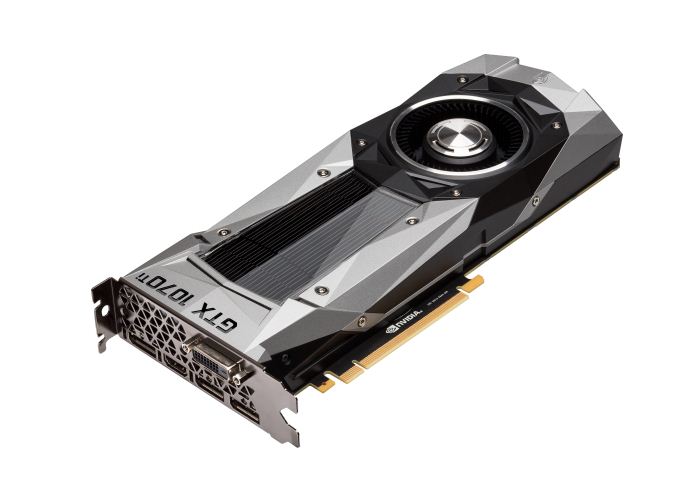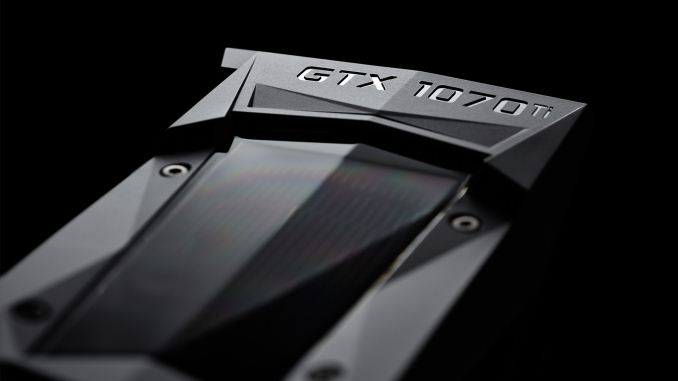The NVIDIA GeForce GTX 1070 Ti Founders Edition Review: GP104 Comes in Threes
by Nate Oh on November 2, 2017 9:00 AM EST- Posted in
- GPUs
- GeForce
- NVIDIA
- Pascal
- GTX 1070 Ti
Final Words
Bringing this review to a close, for better or worse, I think this is a launch that pulls no punches and offers no surprises. While AMD's Radeon RX Vega launch was not as impactful as many of us were hoping, it nonetheless had an impact. And that impact was against the GeForce GTX 1070, where the RX Vega 56 was fast enough to give AMD an edge on price/performance; at least when the card could be found in stock for near-MSRP prices.
Given that the RX Vega 56 placed between the GeForce GTX 1080 and GTX 1070, it was really up to NVIDIA as to if they wanted to respond, and to how. A third card in the enthusiast product stack is the straightforward solution to that problem, as it allows NVIDIA to reinforce their video card lineup against whatever foothold AMD can take. NVIDIA is playing a numbers game here – one that puts their new card just $50 below the GTX 1080 – but it's a careful calculus all the same. This is what a competitive market looks like: a little messier for sure, but also one where there are actions and reactions that give consumers more and better options.
Looking back at NVIDIA’s numbers, they seem more-or-less accurate. Based on the testing done for this review, our numbers have the GTX 1070 Ti around 13% faster than the GTX 1070, and about 8% slower than the GTX 1080. But this doesn’t support or reject the idea that the GTX 1080-1070 performance gap is capable of sustaining a new model there.
Comparing the GTX 1070 Ti head-to-head with AMD's Radeon RX Vega 56 is a little trickier, depending on the games. Generally speaking, the GTX 1070 Ti Founders Edition looks to be on the order of 5% faster than the reference RX Vega 56. The main question then returns to a matter of pricing. Just last week ahead of the GTX 1070 Ti announcement, the RX Vega 64 and RX Vega 56 were selling for $569 and $469 respectively. Since then, they've dropped by $50-$70, with retail prices running around $509 and $399 respectively, almost spot-on MSRP (if at last). Meanwhile as AMD's card prices continue to fluctuate, the new GTX 1070 Ti cards will have to remain within their $449 to $500 range, bounded by the $509 GTX 1080 and the $409 1070.
When graphics card prices change frequently, as they are now, numerous cards will drop in and out of the $250 - $550 area. Recommending the GTX 1070 Ti necessarily pigeonholes consumers to the $449 - $500 price bracket, which seems unwise when they still have the options of looking at cheaper GTX 1080 models, heavily overbuilt GTX 1070s, or even reference RX Vega 56s, all of which have been oscillating in price freely over the past couple of months. In real-world terms, as discussed earlier, today that might be the MSI GTX 1080 Armor 8G and EVGA GTX 1070 FTW Hybrid, both at the same price as a $499 GTX 1070 Ti. Or to put things another way, just last week the GeForce GTX 1070 Ti was poised to be RX Vega 56's direct competitor; this week its more of of a tantalizing spoiler for those who can reach a bit deeper into their wallets.
When it comes to comparing the GTX 1070 Ti to the RX Vega 56, it's ultimately a question of how competitive NVIDIA wishes to be and how quickly they want to react. If NVIDIA needs to completely cut-off the RX Vega 56, they can lower prices, otherwise if they just want to force AMD & vendors to bring their own prices back down to MSRP, then that job has just been done. Otherwise, looking briefly at the RX Vega 64 comparison, as you might expect from how it compares to the GTX 1080, the GTX 1070 Ti doesn't quite have the performance to outdo AMD's flagship air cooled card, leaving AMD in the lead by 5%. This means that the GTX 1070 Ti isn't the RX Vega 64's direct competitor either, however it's a potential spoiler by offering 90-95% of the gaming performance for 88% of the cost (not to mention the superior power efficiency).
Meanwhile, speaking very strictly here just within NVIDA's product stack, at today's $409/$449/$509 prices, the GTX 1070 Ti is, if only slightly, the best bargain of the three cards: it's 13% faster than the GTX 1070 for an 10% price increase, and similarly, the last 8% of the performance of the GTX 1080 comes with a 13% price premium. Otherwise all three cards are very similar, scaling in performance, price, and power consumption as you traverse the narrow $100 range. NVIDIA is pitching the GeForce GTX 1070 Ti as an upgrade for the practically legendary GTX 970, however since it launched at only $329, the GTX 970 was never this expensive. Arguably this is more of a late upgrade option for the GTX 980, but at this point I'm splitting hairs. If you are upgrading from an older NVIDIA card, you have a clear price/performance spectrum to pick from.
Otherwise, as custom GTX 1070 Ti cards hit the market over the next few weeks and settle down, it will become clearer what options they bring and how they fit into the market. Looking at our results, a factory-overclocked custom GTX 1070 Ti could easily hit GTX 1080 levels, but is not likely to be an option for precisely that reason.
Returning to the GTX 1070 Ti Founders Edition, it is a solid card with the GTX 1080 Founders Edition's vapor chamber cooler and reference 5+1 power phase PCB, all at a static $449 and reasonable power consumption. But ultimately it is a reference card with performance in between the GTX 1070 and GTX 1080, with a price to match. Given that GTX 1080 and 1070 models have been in that space for some time, that price point may be better some days and not on others for what you need. This isn't a card that is meant to drastically alter the enthusiast video card market in the last months of the year – which is to say that it doesn't do much to alter the balance between NVIDIA and AMD – but rather it's a card that is designed to offer a proportional option between the GTX 1080 and GTX 1070.












78 Comments
View All Comments
Nfarce - Friday, November 3, 2017 - link
"Vega 56 beats 1070 in almost all games."It beats the reference GTX 1070, but a factory overclocked 1070 pulls ahead again, especially overclocked on top of the factory overclock. Vega 56 (or 64 for that matter) does not have that type of overclocking headroom. This has long been an advantage for Nvidia. AMD GPUs have a history of being terrible overclockers. My old EVGA GTX 970 SSC ACX 2.0+ could be overclocked to 980 performance without even touching the voltage for example.
LastQuark - Saturday, November 4, 2017 - link
Vega 56 BIOS can be upgraded to the Vega 64 BIOS for another 20% speed boost. Vega can only do 5% max. With Vega 56 lower price point by over $50, cheaper Freesync monitor options, and 2x the availability of GSync, Vega 56 is still making a lot of sense for new buyers.B-Real - Thursday, November 2, 2017 - link
According to this theory, you can't compare the 1070 to the Vega56, as the 1070 is 5 degrees Celsius hotter...damonlynch - Thursday, November 2, 2017 - link
It should be "nonetheless", not "none the less", in the introduction to the Final Words ;-)jardows2 - Thursday, November 2, 2017 - link
Good showing. At MSRP, a good argument (from these tests at least) can still be made for Vega 56. Not sure if 1070ti is worth $50.00 more, but you do get a little bit better performance, and most important to me, a lower noise profile at load. Keeping it interesting for sure!CaedenV - Thursday, November 2, 2017 - link
So.... it is essentially a direct Vega 56 competitor except that it will be available on store shelves for purchase?Really hoping that this will cause the normal 1070 prices to drop a bit *fingers crossed*. I picked up a 4k monitor last year and my gaming has been quite limited on it with my GTX 960. A 1070 will fill in quite nicely for now, and next year when the new cards come out I'll pick up a 2nd 1070 for SLi to really make 4K gaming smooth.
BrokenCrayons - Thursday, November 2, 2017 - link
SLI doesn't seem like a good solution these days given tepid support from the GPU manufacturers and very few modern titles that are optimized to take advantage of a 2nd graphics card. You might have a better experience if you set aside the first 1070's cost until next year and then use the funding from both to purchase a 1080 or just hang on to see what happens with Volta since there'll likely be consumer GPUs available sometime in 2018.vladx - Thursday, November 2, 2017 - link
AMD has no chance at all, a RX Vega 56 in my country is $150 more expensive than the newly released GTX 1070 Ti.Sorjal - Thursday, November 2, 2017 - link
Easiest check to see potential mining impact is toss a ti and non in a pc and test with some miner program. Nicehash legacy is probably the best for comparative stats. Run their benchmark on both cards on precise and compare the results. There will be some variance, but it should provide a decent reference. Nvidias are typically used on ones that are more gpu intensive, with Zcash probably the largest. AMD works off their bandwidth and are favored for corresponding currencies like Etherium and Monero. The nice hash legacy will test against most of the major ones including Ethereum, Monero, and ZCash.Given the increased CPU performance, it is probably being tested mining wise as we speak
Sorjal - Thursday, November 2, 2017 - link
Remember to overclock and undervolt. Energy effeciency is a large factor. 1070's seem to be run between 65-70% power limit. A voltage meter on the outlet may be useful in this case as you can look at the voltage change for each test for each card